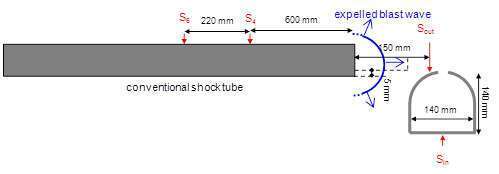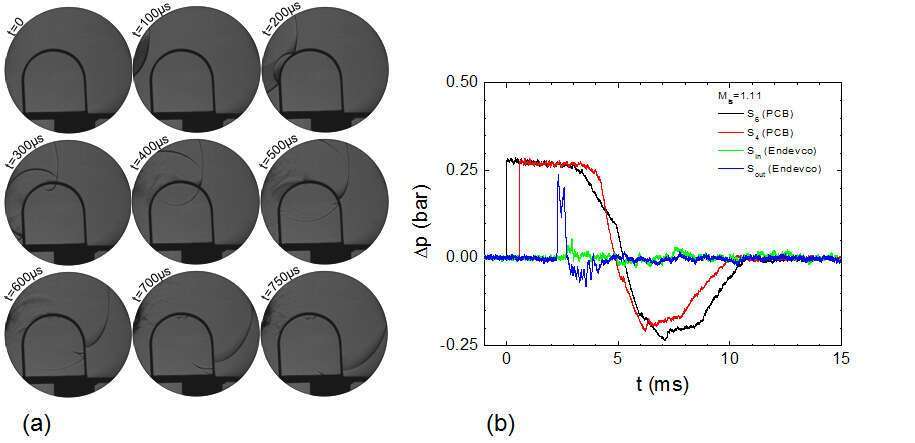The aim of the present work is to quantify the part of a blast wave which penetrates in a cavity after impacting it.
Both experimental and analytical works have been realized on similar investigations and, principally, focused on the transition from Mach to regular reflection of the shock wave (Ben-Dor and Takayama, 1985), or the complex flow features (Igra et al., 1996 and Skews and Kleine, 2007).
Various models of cavities were drilled in several simple forms and one of them is, as an example, presented on Figure 1. The blast wave was experimentally generated by expelling a shock wave from a conventional shock tube (T80).
As an example, figure 2 (a) qualitatively illustrates flow features resulting from a blast wave impact on cavity presented in figure 1.

Figure 1: Scheme of the experimental set-up and example of mode made by a parallelepiped surmounted by half a cylinder and drilled by a rectangular opening.
From the other hand, figure 2 (b) quantitatively shows that for an overpressure of about 230 mbar outside of the cavity, the maximum overpressure recorded inside and at the bottom of the cavity is about 49 mbar which corresponds in terms of intensity to a blast wave penetration of about 25%.

Figure 2: (a) Sequences of Schlieren photographs (20,000 frames/second) showing the interaction of a blast wave generated from the expelling of a Mis=1.11 plane shock wave from T80 conventional shock tube with the cavity presented on figure 1, and drilled with a 35x20mm2 rectangular opening. (b) Typical pressure signals illustrating the interaction of a blast wave generated from the expelling of a Mis=1.11 plane shock wave from T80 conventional shock tube with the cavity. Pressure gauges S6 and S4 record the shock wave overpressure in the shock tube, Sout records the blast wave just before interring the cavity and Sin that at the bottom within the cavity.
We hope to be able to present our whole results during the symposium.
References:
- Ben-Dor and K. Takayama, J. Fluid Mech. (1985), vol. 158. pp. 365-380.
- Igra, J. Facovitz, H. Reichenbach and W. Heilg, J. Fluid Mech. (1996), Vol. 313, pp 105-130.
- W. Skews and H. Kleine, J. Fluid Mach., J. Fluid Mech. (2007), vol. 580, pp 481-493.

